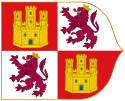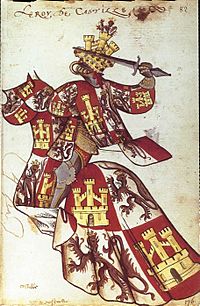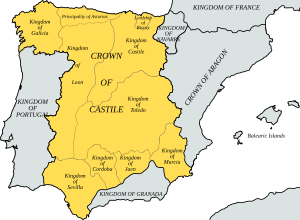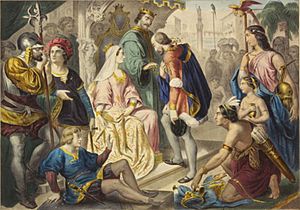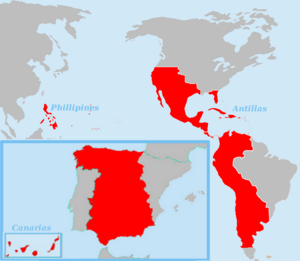Crown of Castile facts for kids
Quick facts for kids
Crown of Castile
|
|||||||||||||||||
|---|---|---|---|---|---|---|---|---|---|---|---|---|---|---|---|---|---|
| 1230–1715 | |||||||||||||||||
|
|
|||||||||||||||||
|
Anthem: "Spanish March"
|
|||||||||||||||||
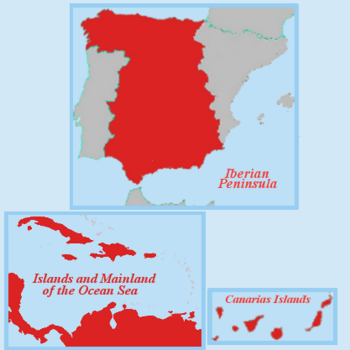
The Crown of Castile in the early 16th century.
|
|||||||||||||||||
| Capital |
|
||||||||||||||||
| Common languages |
|
||||||||||||||||
| Religion |
|
||||||||||||||||
| Demonym(s) | Castilian | ||||||||||||||||
| Government | Monarchy subject to fueros | ||||||||||||||||
| Monarch | |||||||||||||||||
|
• 1230–1252
|
Ferdinand III (first) | ||||||||||||||||
|
• 1474–1504
|
Isabella I and Ferdinand V | ||||||||||||||||
| Legislature | Cortes of Castile | ||||||||||||||||
| Historical era | Middle Ages and early modern period | ||||||||||||||||
| 23 September 1230 | |||||||||||||||||
| 19 October 1469 | |||||||||||||||||
| 2 January 1492 | |||||||||||||||||
| 1512 (annexed 7 July 1515) | |||||||||||||||||
|
• Ascension of Charles I
|
23 January 1516 | ||||||||||||||||
| 1715 | |||||||||||||||||
| Area | |||||||||||||||||
| 1300 | 335,000 km2 (129,000 sq mi) | ||||||||||||||||
| Population | |||||||||||||||||
|
• 1300
|
3,000,000 | ||||||||||||||||
| Currency |
|
||||||||||||||||
|
|||||||||||||||||
The Crown of Castile was a powerful kingdom in the Iberian Peninsula. It was formed in 1230 when the kingdoms of Castile and León joined together. This happened when Ferdinand III, who was already King of Castile, also became King of León.
The Crown of Castile continued to exist even after its rulers married into the Crown of Aragon in 1469. This marriage created a "personal union" under the Catholic Monarchs. The Crown of Castile finally ended in 1715. This was due to new laws called the Nueva Planta decrees by Philip V.
In 1492, Christopher Columbus sailed across the Atlantic and discovered the Americas. This was a huge moment for Castile. The new lands became part of the Crown of Castile. Over time, Castile grew into a global empire. It conquered vast areas like the Aztec Empire and the Inca Empire. It also took control of the Philippines.
Even after Castile joined with Aragon, its rulers kept the title "King of Castile." This continued through the 16th and 17th centuries under the Habsburg family.
In the early 1700s, Philip of Bourbon won the War of the Spanish Succession. He then brought the Crown of Aragon and the Crown of Castile together. This created the new country of Spain.
Contents
History of the Crown of Castile
How Castile and León United
Two Kingdoms: León and Castile
The Kingdom of León grew out of the Kingdom of Asturias. The Kingdom of Castile started as a smaller area within León. In the 11th century, Castile became its own kingdom.
Steps Towards Unification
The two kingdoms had joined together twice before.
- From 1037 to 1065, they were united under Ferdinand I of León. After he died, his sons divided the kingdoms again.
- From 1072 to 1157, they were united under Alfonso VI, Urraca, and Alfonso VII. In 1157, the kingdoms were divided once more between Alfonso's sons.
Between 1199 and 1201, Alfonso VIII of Castile invaded the Kingdom of Navarre. His armies took control of areas like Álava, Durangaldea, and Gipuzkoa. These areas kept their local laws under Castilian rule.
The Crown of Castile: From Ferdinand III to Charles I
Joining Kingdoms Under Ferdinand III
Ferdinand III became King of Castile in 1217. He inherited León from his father in 1230. From this point, the two kingdoms were permanently united. They were called the Kingdom of León and Castile, or simply the Crown of Castile.
Ferdinand III conquered the Guadalquivir Valley. His son, Alfonso X, conquered the Kingdom of Murcia. This greatly expanded the Crown of Castile's territory. Kings of Castile used many titles, including "King of Castile, León, Toledo, Galicia, Murcia, Jaén, Córdoba, Seville." The heir to the throne has been called the Prince of Asturias since the 14th century.
United Parliament and Laws
Soon after the kingdoms united, their parliaments also joined. The parliament, called the Cortes, had three groups: nobles, church leaders, and city representatives. It included people from Castile, León, Galicia, Toledo, and the Basque Provinces.
Over time, the number of cities sending representatives changed. Finally, John I set the list of cities. These included Burgos, Toledo, León, Seville, and Madrid. Granada was added after its conquest in 1492.
Under Alfonso X, the Cortes of both kingdoms often met together. Later, representatives asked for the parliaments to always be reunited.
The new kingdom also created a unified legal system. Important laws included the Siete Partidas (around 1265) and the Leyes de Toro (1505). These laws were used until 1889.
Languages and Universities
In the 13th century, many languages were spoken in Castile and León. These included Castilian, Leonese, Basque, and Galician-Portuguese. But Castilian became more and more important for culture and communication. A famous example is the poem Cantar de Mio Cid.
Under Alfonso X, Castilian became the official language. All public documents were written in Castilian. Arabic legal papers were also translated into Castilian, not Latin. Some historians believe this happened because Castilian was a strong new language. Others think it was due to Jewish scholars who preferred Castilian over Latin, the language of the Church.
In 1492, the first book on Castilian grammar was published. Castilian was later brought to the Americas by Spanish explorers. Because of its importance, Castilian is also known as Spanish.
Many universities were founded in the 13th century. They taught in Castilian. These included the University of Salamanca and the University of Valladolid. They were some of the first universities in Europe.
During this time, sheep farmers formed a powerful group called the Mesta. Castile became a major exporter of wool in the late Middle Ages.
The Trastámara Family Takes Power
A civil war broke out in Castile. It was between supporters of Henry of Trastámara and Peter I. The nobility supported Henry, while Peter had support from Jewish people and town councils. When Henry's side won, much of the royal wealth was given to the nobles. This change also led to more anti-Jewish feelings in Castile.
After Alfonso XI died, his sons, Peter and Henry, fought for the throne. This conflict became part of the Hundred Years' War between England and France. Peter was the rightful heir, but Henry, an illegitimate son, challenged him.
Peter allied with Edward, the Black Prince from England. In 1367, the Black Prince helped Peter win a battle. But when Peter didn't pay him, the Black Prince left. Henry then continued the fight. In 1369, Henry won the Battle of Montiel and had Peter killed.
In 1371, the Black Prince's brother, John of Gaunt, 1st Duke of Lancaster, married Peter's daughter, Constance. In 1386, he claimed the Castilian throne for his wife. He invaded Castile and took several cities. He asked John I, Henry II's son, to give up the throne.
John I refused. Instead, he suggested that his son, Henry, marry John of Gaunt's daughter, Catherine. This marriage created the title Prince of Asturias for Henry and Catherine. This ended the conflict and brought peace between England and Castile.
Relations with Aragon in the 14th Century
Under Henry III, the king's power grew stronger than the nobility's. Later, Henry shared some power with his brother Ferdinand I of Antequera. Ferdinand became King of Aragon in 1412.
When John II became king at 14, he relied on his advisor, Álvaro de Luna. Álvaro was allied with the lesser nobility, cities, and the church. This made the powerful Castilian nobles and the Aragonese princes unhappy. They wanted to control the Castilian crown. This led to a war between the two kingdoms in 1429-1430. Álvaro de Luna won and forced the Aragonese princes out of Castile.
Another Fight for the Throne
Henry IV tried to make peace with the nobles, but he struggled. When his wife, Joan of Portugal, had a daughter, Infanta Joanna, some claimed she was not the king's child.
The nobles pressured Henry IV to name his half-brother, Alfonso, as his successor. This left Infanta Joanna out of the line of succession. After Alfonso died, Henry IV signed a treaty with his half-sister Isabella I. He named her his heir, if she married someone he approved of.
The Catholic Monarchs: Joining with Aragon
In 1469, Isabella I secretly married Ferdinand II, who was the heir to the throne of Aragon. This marriage led to the two crowns being united in 1479 when Ferdinand became King of Aragon. This union became fully effective under their grandson, Charles I.
Isabella and Ferdinand were related and married without the Pope's direct approval at first. Later, Pope Alexander VI gave them the special title of 'los Reyes Católicos' (the Catholic Monarchs).
Isabella's half-brother, Henry IV, saw her marriage as a broken promise. He wanted Castile to ally with Portugal or France, not Aragon. So, he named his daughter, Infanta Joanna, as his heir instead of Isabella. When Henry died in 1474, the War of the Castilian Succession began. It lasted until 1479, when Isabella and her supporters won.
After Isabella's victory, the two crowns were united under the same rulers. However, this was a "personal union." Both kingdoms largely kept their own laws and parliaments. The only shared institution was the Spanish Inquisition. Castile was the stronger partner because it was larger and had more people.
The Castilian nobility had become very powerful. The monarchs wanted to strengthen their own authority. They created a law enforcement group called the Santa Hermandad (Holy Brotherhood). They also took steps against the nobles, like destroying feudal castles. The monarchy also gained more control over military groups and the justice system. To better control cities, they appointed corregidores to supervise city councils.
In religion, they encouraged Jews to convert to Catholicism. In 1492, the monarchs decided that Jews who would not convert would be expelled. Between 50,000 and 70,000 people were expelled from Castile. From 1502, they also began to convert the Muslim population.
Between 1478 and 1497, the monarchs conquered the Canary Islands. On January 2, 1492, they entered Granada's Alhambra. This marked the end of the Reconquista (Reconquest) of Spain from Muslim rule. Also in 1492, Christopher Columbus claimed new lands in the Americas for Castile. In 1497, Castile conquered Melilla in North Africa.
Regency Period – Joanna I
When Queen Isabella I died in 1504, the crown passed to her daughter, Joanna. Joanna was married to Philip of Austria. Isabella knew her daughter might struggle to rule. So, she named Ferdinand as regent if Joanna "couldn't fulfill her duties."
In 1505, it was decided that Philip I, Ferdinand V, and Joanna would share the government. But Philip and Ferdinand had a poor relationship. Ferdinand gave up his power in Castile to avoid a fight.
In 1506, Ferdinand returned to Aragon. Philip was recognized as King of Castile, with Joanna as co-monarch. Philip died soon after. Ferdinand returned in 1507 to be regent for Joanna again. Joanna was kept in isolation at the Santa Clara Convent in Tordesillas from 1510 until her death over forty years later.
In 1512, a combined Castilian-Aragonese force invaded Navarre. Most of the Kingdom of Navarre south of the Pyrenees was added to Castile.
The Crown of Castile within Habsburg Spain
Charles I Becomes King

Charles I inherited many lands. He received the Crown of Castile, the Crown of Aragon, and the Netherlands. He became ruler of Aragon and Castile (including the Americas) in 1516. He ruled with his mother, Queen Joanna, but she remained confined. In 1519, Charles was also elected Holy Roman Emperor. He is better known as Charles V, Holy Roman Emperor.
Charles I was not popular in Castile. He was born in Ghent and gave important jobs to people from Flanders. He also used Castilian money for his court. The Castilian nobles and cities were ready to rebel to protect their rights. Many Castilians preferred Charles's younger brother, Ferdinand, who grew up in Castile.
In 1518, the Castilian parliament in Valladolid protested against foreign officials. They forced the king to respect Castilian laws and remove foreigners from important jobs. They also demanded he learn to speak Castilian.
Charles needed Castile's wealth for his empire. The riches from the Americas came through Castile, which was a very rich part of Europe. Castilians worried about being drawn into a large empire. In 1520, the parliament in Toledo refused to give the king more money. The same happened in Santiago de Compostela. Finally, in A Coruña, some members were bribed, and others were kept out. This allowed the subsidy to be approved. People attacked the homes of those who voted for it.
When Charles left Castile in 1520, the Castilian War of the Communities broke out. The rebels wanted Joanna to be the sole monarch. Joanna sympathized with them but refused to sign any documents against her son. The rebels were defeated in 1521. After this, the parliament had less power. To prevent Joanna from being used by opponents, Charles kept her confined until her death in 1555. After that, Charles became the only ruler of Spain.
Philip II's Imperial Rule
Philip II continued his father's policies. He made Castile the center of the Spanish Empire, with all administration in Madrid. Other Spanish regions kept some self-rule.
Castile carried most of the empire's financial burden. Under Philip II, the cost quadrupled. He increased existing taxes and created new ones. In 1567, Philip ordered the La Pragmática. This law forced all Moriscos (Muslims who had converted to Christianity) to give up their traditions. This led to the Morisco Revolt (1568–1571), which was put down.
Castile faced an economic downturn in 1575. In 1590, the Cortes approved a new tax on food called the millones. This hurt Castilian cities and the economy.
Later Habsburg Rulers
Under Philip III, the nobility regained power in governing the country. Religious persecution led Philip to order the expulsion of the Moriscos in 1609.
To keep the Spanish Empire strong, Gaspar de Guzmán, Count-Duke of Olivares, King Philip IV's main advisor, tried to make reforms. One idea was the Unión de Armas. This would create a new army of 140,000 reservists. Each part of the kingdom would contribute people. But his plans for a united kingdom did not work. The Spanish Crown remained a group of separate kingdoms.
After Philip IV died in 1665, Charles II was unable to govern well. Spain suffered economically, and different advisors fought for power. Charles II died in 1700 without children. This led to the War of the Spanish Succession.
After the war, all the territories were united into a single country under the Crown of Spain.
Territories of the Crown of Castile
In Spain
- Kingdom of Castille
- Kingdom of León
- Principality of Asturias
- Kingdom of Galicia
- Lordship of Biscay
- Province of Gipuzkoa
- Province of Álava
- Extremadura
- Kingdom of Toledo
- Kingdom of Murcia
- Kingdom of Córdoba
- Kingdom of Jaén
- Kingdom of Seville
- Kingdom of Granada (after 1492)
- Kingdom of Navarre (after 1512)
Overseas Territories (before 1715)
- Kingdom of the Canaries
- Viceroyalty of the Indies (1492–1535)
North American and Asian Territories
- Viceroyalty of New Spain (after 1535)
- Kingdom of Mexico
- New Kingdom of Galicia
- Captaincy General of Guatemala or Kingdom of Guatemala
- Kingdom of New Biscay
- New Kingdom of León
- Santa Fe of New Mexico
- New Extremadura
- Province of New Navarre
- Province of the Californias
- Provincia de Venezuela
- Captaincy General of the Philippines
- Captaincy General of Cuba
- Captaincy General of Puerto Rico
- Captaincy General of Santo Domingo
- Captaincy General of Yucatán
South American Territories
- Viceroyalty of Peru (after 1542)
- Province of Tierra Firme
- New Kingdom of Granada
- Kingdom of Quito or Presidency of Quito
- Kingdom of Peru
- Province of Charcas
- Captaincy General of Chile (also called Kingdom of Chile)
- Governorate of the Río de la Plata
In these overseas territories, a viceroy acted "in the place of the king." They held all public power and were appointed and removed by the monarch. They followed the orders of the King of the Crown of Castile.
See also
 In Spanish: Corona de Castilla para niños
In Spanish: Corona de Castilla para niños


